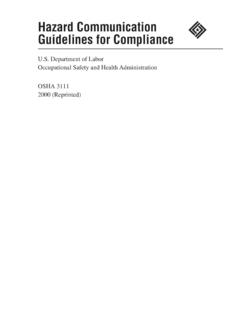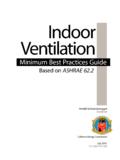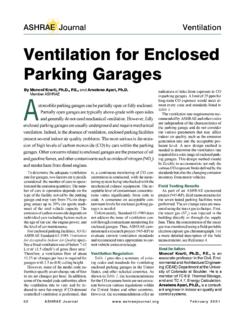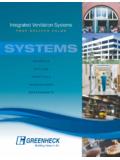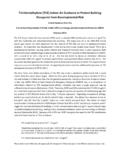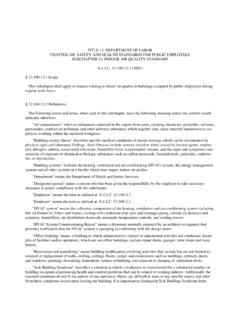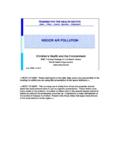Transcription of Preventing Mold-Related Problems in the Indoor …
1 Preventing Mold-Related Problems in the Indoor Workplace A Guide for Building Owners, Managers and Occupants osha 3304-04N 2006. Employers are responsible for providing a safe and healthful workplace for their employees. osha 's role is to assure the safety and health of America's workers by setting and enforcing standards; provid- ing training, outreach and education; establishing partnerships; and encouraging continual improve- ment in workplace safety and health. This handbook provides a general overview of a particular topic related to osha standards. It does not alter or determine compliance responsibilities in osha standards or the Occupational Safety and Health Act of 1970. Because interpretations and en- forcement policy may change over time, you should consult current osha administrative interpretations and decisions by the Occupational Safety and Health Review Commission and the Courts for additional guidance on osha compliance requirements.
2 This publication is in the public domain and may be reproduced, fully or partially, without permission. Source credit is requested but not required. This information is available to sensory impaired individuals upon request. Voice phone: (202) 693- 1999; teletypewriter (TTY) number: (877) 889-5627. Preventing Mold- Related Problems in the Indoor Workplace A Guide for Building Owners, Managers and Occupants Department of Labor Occupational Safety and Health Administration osha 3304-04N. 2006. Contents Introduction .. 4. Background .. 5. Overview .. 6. Mold .. 6. Where molds are found .. 6. The causes of molds in buildings .. 6. Why building owners and managers need to be concerned about mold .. 7. Building-related illnesses (BRIs).
3 8. How sick building syndrome (SBS) differs from BRI .. 8. BRIs linked to mold exposure .. 8. Building-Related Illnesses .. 9. Health effects that can be caused by mold .. 9. Preventive Maintenance .. 9. Preventing mold growth in occupied areas .. 9. Preventing mold and bacterial growth in the building's ventilation system .. 10. Cleaning the building's air ducts .. 11. Protecting building occupants during building renovations or remodeling .. 11. Building Evaluation .. 12. What to do if you suspect that your building has mold .. 12. Selecting a qualified professional who can assist in providing a safe and healthful work environment .. 12. Sampling for mold .. 13. Mold sampling strategies .. 14. 2. The meaning of mold sampling results that are in CFU/m2 and CFU/m3.
4 14. Mold Control and Remediation .. 15. The purpose of mold remediation .. 15. Actions for Employees to Take .. 15. What to do about mold in the workplace .. 15. Additional Help in Addressing Mold-Related Problems .. 16. Where to get more information .. 16. Methods .. 17. Appendix .. 18. Allergy .. 18. Allergic rhinitis .. 18. Allergic asthma .. 18. Hypersensitivity pneumonitis .. 19. Ventilation pneumonitis .. 20. How HP differs from asthma .. 20. Infection .. 20. Systemic fungal infections .. 20. Toxin-Mediated Conditions .. 21. Mycotoxins .. 21. Toxic mold .. 22. References .. 23. osha Assistance .. 27. osha Regional Offices .. 32. 3. Introduction This guide provides basic information about mold, mold sources, and building-related illnesses.
5 Brief discussions are included on building design considerations for healthy Indoor air, as well as building evaluation and sampling for mold. However, detailed information about Indoor air quality diagnostic studies ( , normal vs. abnormal levels) and the design and execution of exposure sampling strategies is not included as this information is beyond the scope of this initiative. For approaches to remediation of moldy areas and the appropriate response based on the degree of the contamination, the reader should consult osha 's Safety and Health Information Bulletin (SHIB 03-10-10) A Brief Guide to Mold in the Workplace (1). Additional information on mold is available through osha 's Molds and Fungi safety and health topics webpage at , which contains a collection of hyperlinks to various sources of information regarding mold.
6 This guidance document is not a standard or regulation, and it creates no new legal obligations. The guidance is advisory in nature, informational in content, and is intended to provide relevant information to building owners, managers, and occupants regarding mold prevention and remediation in buildings. Contractors and other professionals ( , envi- ronmental consultants and health or safety professionals) who respond to mold and moisture situations in buildings, as well as members of the general public, also may want to refer to these guidelines. Employers are required to comply with hazard-specific safety and health standards as issued and enforced by either the Federal Occupational Safety and Health Administration ( osha ), or an osha -approved State Plan.
7 In addition, Section 5(a)(1) of The Occupational Safety and Health Act, the General Duty Clause, requires employers to provide their employees with a workplace free from recognized hazards likely to cause death or serious physical harm. Employers can be cited for violating the General Duty Clause if there is such a recognized hazard and they do not take reasonable steps to prevent or abate the hazard. However, failure to implement these guidelines is not, in itself, a violation of the General Duty Clause. Citations can only be based on standards, regulations, and the General Duty Clause. 4. Background In 1994, osha published in the Federal Register a comprehen- sive proposed rule on Indoor air quality (IAQ) that addressed adverse health effects attributable to environmental tobacco smoke (ETS) and other Indoor pollutants, including bioaerosols (59 FR.)
8 15968). During the IAQ rulemaking, the Agency received comments and scientific and technical information on Indoor mold exposures associated with building-related illnesses (BRIs). While the IAQ. proposed rule was withdrawn in its entirety in December 2001 (66. FR 64946), the Agency retained the voluminous docket (consisting of approximately 120,000 documents), which contains valuable information on ETS and other Indoor pollutants, such as chemicals, bacteria, and molds. In preparing this guide osha has reviewed the IAQ docket and recent scientific literature pertaining to mold As a result of this review, it is clear that the entrance of water ( , incursion) into buildings that are damaged, poorly designed, or improperly maintained, is the main source of mold-associated building-related illness.
9 Consequently, the focus of the review was directed toward preventive measures to reduce potential environ- ments for mold growth at the source. The purpose of this guide is to help owners, managers, and occupants understand and prevent building-related illnesses associated with mold Problems in offices and other Indoor It is not the intent of this guide to address the special considerations of building designers, developers, and similar building professionals; however, they may find certain general information helpful. In addition, health care professionals, maintenance workers, custodians, and others who have a role in the prevention and correction ( , remediation) of mold Problems in buildings may derive benefit from the information and recom- mendations outlined here.
10 1. See Methods Section of this document for further details regarding the process used to review the scientific literature and analyze the IAQ docket information concerning mold exposures. 2. Building-related illnesses discussed in this guide are limited to those illnesses that arise in nonindustrial, nonresidential buildings. 5. Overview Mold Molds are the most common forms of fungi found on the earth. Fungi are classified as neither plants nor animals, and include yeasts, mildews, puffballs, and mushrooms (2). Most molds re- produce through the formation of spores, tiny microscopic cells that float through the Indoor and outdoor air on a continual basis (3). We are all exposed to mold spores in the air we breathe on a daily basis, both indoors and outdoors.









